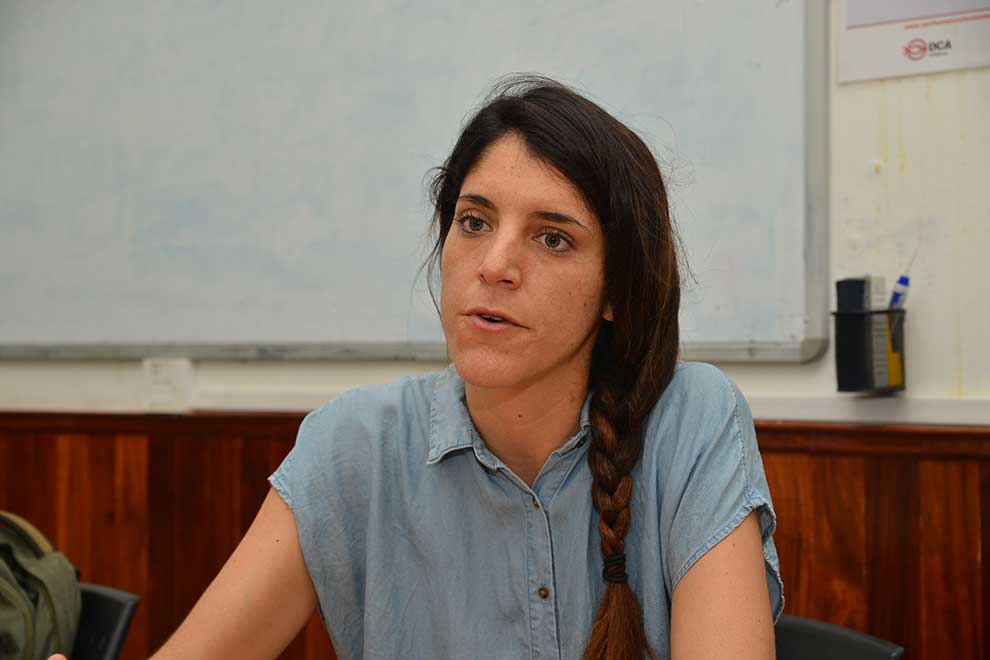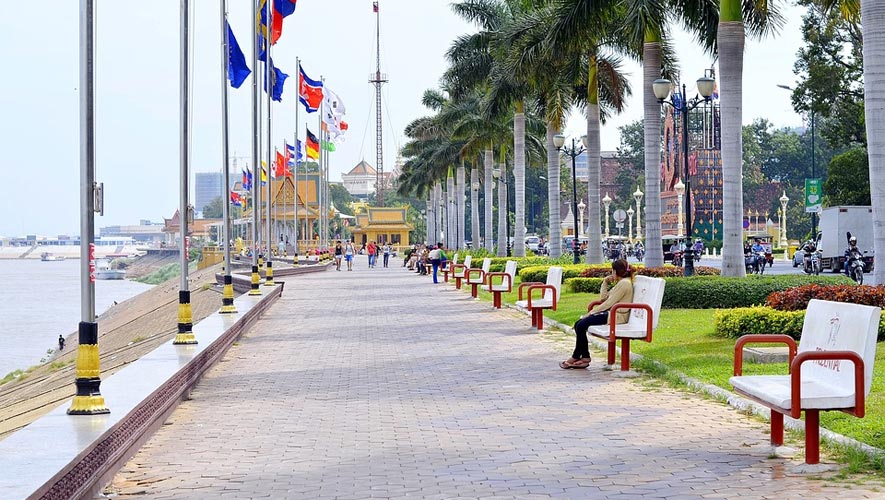The Asian Development Bank (ADB) and International Rice Research Institute (IRRI) reports that adapting “climate-smart” practices has increased the income of farmers compared with those using conventional production methods.
For the latest Cambodian Business news, visit Khmer Times Business
The latest report from the ADB and IRRI titled “Climate-Smart Practices for Intensive Rice-Based Systems in Bangladesh, Cambodia, and Nepal” shows that mechanisation, specifically regarding direct-seeded rice (DSR) technology increased the cost–benefit ratio compared with traditional methods of cultivation. The new rice cultivars also exhibited lower greenhouse gas emissions.
“Rice-based farming systems can thus be ultimately sustained and food security can be strengthened,” according to the ADB. “The spread of cost-effective and climate-smart production technologies in rice-based farming systems in Bangladesh, Cambodia and Nepal will go a long way towards solving sustainable development issues.”
The ADB says that in Cambodia, mechanised Direct Seeds Rice (DSR) technology decreased use of labour by between 60 percent to 79 percent compared with traditional transplanted puddled systems. It also increased the yield of rice by between 26 percent to 50 percent compared with the traditional transplanted system. It saved water by about 19 percent to 32 percent.
Meanwhile, greenhouse gas emissions were 68 kilogrammes per hectare under DSR compared with 98 kilogrammes per hectare under the transplanted puddling system.
It adds that DSR technology reduces water loss through puddling, surface evaporation and percolation. Repeated puddling disturbs the soil’s physical properties, thus impairing drainage and having a negative effect on subsequent plant growth in non-rice crop rotations.
“Agricultural practices must change to deal with climate-and resource-related challenges. Water-saving technologies for crop diversification, labour-saving mechanisation and improved management practices must be introduced,” says the ADB’s report.
It says the DSR system is less labour-intensive, consumes less water, is more conducive to mechanisation and results in less methane emissions than the transplanting method. These combinations of technologies therefore offer better opportunities to farmers to improve the productivity of rice and non-rice crop production and achieve better income diversification, while also helping to reduce their carbon footprint.
The Kingdom’s leading rice exporter Amru Rice (Cambodia) Co Ltd Chief Executive Officer Saran Song says that smart farming, practised in other countries, might be the answer to boosting the agriculture industry.
Song says that technology could boost competitiveness, ensure sustainability and increase productivity. It might also encourage young people to become involved in the sector.
“By adopting technology, farmers become entrepreneurs, not just farmers. If things work out, they might continue farming because of better returns,” Song says.
In 2017, the International Finance Corp (IFC) agreed to support Amru over a three-year period to implement the sustainable rice platform (SRP) standard. SRP was developed by the United Nations Environment Programme and International Rice Research Institute.
Following that, the two entities created an agriculture application called Farmforce whereby farmers would first jot down their daily rice-planting activity on notebooks. This data which includes usage of fertiliser, water and labour, as well as planting and harvesting cycles, is then fed into the app.
Farmforce coordinates activities of field staff and farmers and tracks harvest and growing activities in real-time. It provides full traceability from field to market, complies with food safety and sustainability standards, accesses centralised digital records, streamlines logistics, manages cash and input loans and raises potential buyer numbers for smallholder producers.
Efforts to promote technology-based rice farming should highlight the reduced cost of production that comes with mechanisation and the increases in yield that can be achieved through the adoption of best management practices.
It is time for farmers to adapt with the technology to fight against climate-change. It is the right moment to do it now, says Celia Del Campo Aragones, technical officer on the Sustainable Agriculture and Climate Change of Dan Church Aid (DCA) Cambodia.
DCA is also in collaboration with EU-Civil Protection and Humanitarian Aid to launch the Khmer Smart Farming App. The EU-funded app provides weather forecasts and information on crops and planting techniques to farmers.
She adds the specialised app helps Cambodian farmers to cope with unpredictable weather. She says most of Cambodia’s population are farmers. For centuries they have relied on the monsoon but climate change makes it unpredictable.
“Our Khmer Smart Farming App is to forecast the temperature, precipitation and wind,” says Aragones. “The app will also provide farmers with information for 12 different crops and information about what kind of soil works best with different kinds of crops, what the best time for irrigation is and what kind of crops we can we inter-crop or rotate to benefit production,” she adds.
“For this pilot project, precisely we have been working with a small group of around 100 farmers in Kampong Speu and we will expand to around 2,000 farmers by end of this year and will reach farmers across the country in the next three to five years,” she adds.

“Now farmers can adopt the technology to grow their farm as they gain access to weather, temperature and other input information,” she adds. Aragones says together this will help farmers to make a decent living from farming activities.
As of October this year the yield of the rainy season rice was more than 1.385 million tonnes from 352,323 hectares of harvested land, a decrease of about 313,679 tonnes from the same period last year, according to a report from the Ministry of Agriculture, Forestry and Fisheries.
An official from the Agriculture Ministry says that the yield will be changed because more than 2 million hectares of paddy rice will be harvested from November until January.
Among 2.645 million hectares of this year’s rainy season rice is mostly carried out by the conventional methods of both sowing and transplanting, proving farmers around 3.93 tonnes per hectare.
DSR technology could help the farmers from losing seedlings and it helps crop to grow well and provide a high yield, but not many farmers are implementing the technology, says Ouk Makara, director of the Cambodian Agricultural Research and Development Institute (CARDI).
He adds that the use of drilling techniques will keep the rice seedlings under the ground when it is dry so that the it can survive despite a lack of rain or other water source. Then, when the rain comes, and there is water in the paddy field, those seedlings will still be growing.
“DSR can be done in the dry season or without water. It adapts to climate change. However, for sowing conventionally, it is necessary to have water in the field,” Makara adds.
Makara agreeds that DSR technology is less implemented among farmers because they (farmers) prefer conventional rice sowing and transplanting.
The use of technology on a farm shows the growing use of mechanisation in agriculture, says Nhep Srorn, director of Takeo province’s agriculture department. He says that by using the technology and machinery in the agriculture sector, it saves labour, easily allows the use of fertilisers, manages pests and gets high yields.
Nhep adds that the use of technology and machinery is to use less water and for crops to be more resilient to climate change. “However, we can see that very few farmers in our province are using the technology for transplanting. They mostly prefer the traditional methods,” he adds.
Based on the findings of the field experiments and consultation with farmers and other stakeholders in Cambodia, both the ADB and IRRI recommended that the government explains the potential technology based on proper information or data on the ground first.
It means there is a need to assess current practices, level s of mechanisation and availability of services. Custom-tailored technologies should be developed through field experiments and should be validated involving farmers in the process.
They says a holistic approach should be followed to support the adoption of climate-smart technology with complete requirements including improvement in service delivery and knowledge transmission channels.
Similarly, a smart extension service system should be developed to improve farmers’ access to information and knowledge. As a critical resource in rice production, good-quality seeds suitable for climate-smart practices should be made readily available.
The ADB adds that the government should also establish a community-based service centre to provide support for climate smart agriculture to farmers. A platform involving scientists, farmers, the private sector and academia working together in partnership to support climate-smart agriculture would be useful.
“In Cambodia, the government needs to create an enabling environment for private companies to manufacture custom-designed machines and provide after-sales services. At the same time, the capacity of the extension service to train farmers on climate-smart technologies and work with the private sector in partnership should be enhanced,” the bank says.
It adds that majority of smallholder farmers are unable to own machinery by themselves to practise climate-smart agriculture. The private sector should be incentivised to set up hiring centres from where farmers can rent machinery.
Meanwhile, farmers’ cooperatives should be promoted as well to set up hiring centres. However, such cooperatives should be run following corporate principles, i.e., with a clear demarcation between equity holders and management personnel, all of whom should be accountable for their decisions Rice makes up a considerable part of the Cambodian diet.
The ADB says that the challenges of the machinery introduced in developing countries do not have the characteristics that farmers look for in machinery and equipment suitable for small-farm conditions – such as durability, lightness, compactness, low power consumption, multipurpose use and low cost.
In some cases, even if the machines are adaptable, the lack of skilled personnel to operate, maintain and repair them leads to problems with spare parts and after-sales service.
Machinery supply chain management is weak. Low-volume, seasonal demand from farms does not make the machinery supply business profitable and attractive to investors, especially with arbitrary taxes and duties on raw materials and fabricated machinery adding to the already high costs of production, the ADB says.




